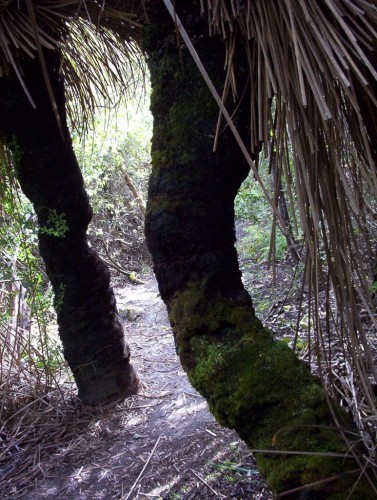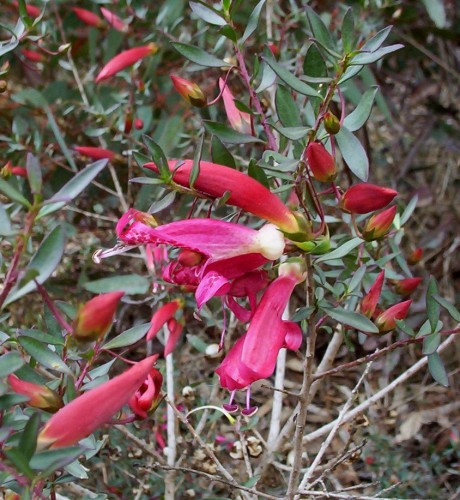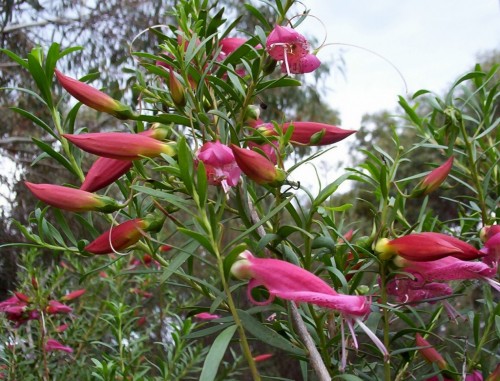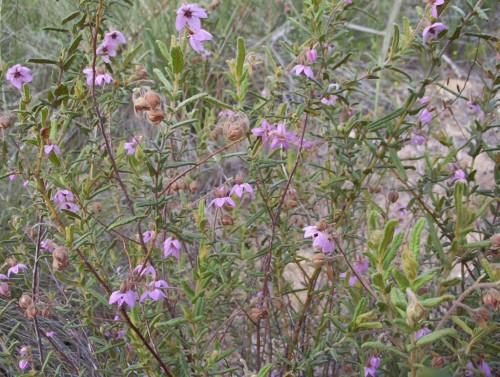Xanthorrhoea semiplana (Yacka, Grass Tree)
This photo was taken because it was fascinating to see the age of these Grass Trees. The walking path passed between these two trunks. There is moss growing on the trunks. I would love to at least see my little plant make the canopy of leaves showing on these.
This plant seems to be a very hardy one once established. The flower stalk can be up to two and a half metres long. They often have a kink or distortion in the spike.
Eremophila maculata compact form (Emu Bush)
This compact form of Eremophila maculata is a delight. It only grows about 60cm tall by about the same wide. The flowers are out of proportion to the size of the plant, being the same size as those on Eremophila maculata (Spotted Emu Bush).
All the desirable qualities apply to this plant. It is small, frost and drought hardy and lime tolerant. I think this plant flowers for a much longer period than the standard Eremophila maculata. Everyone admires the brilliantly coloured flowers. Like all Eremophilas, it benefits from light pruning or trimming from a young age.
The Mallee Ringnecks adore it and they can’t be wrong. It was an amusing sight, which we caught with the camera, to see one of the locals fly to the vicinity of the bush, waddle up to it and proceed to pick the flowers, get the nectar from the base of the tube and drop the flower to the ground before proceding to the next flower. The ground surrounding the bush was littered with chewed flowers. Destructive little beast! Incredibly this bush produces so many flowers that the chewed ones were not missed.
Eremophila maculata (Spotted Emu Bush)
This is another very hardy plant. Eremophila maculata (Spotted Emu Bush) occurs in a number of colours and habits, from a shrub to two and half metres by about the same wide, to a sprawling plant about half a metre tall by about 2 metres across.
The plant in the photo is a dark pink form to 2 metres high and across here. It has large tubular flowers with spots inside the throat of the tube. The Honeyeaters absolutely love this shrub. They have been very busy nesting and arguing over territory and there seems to be a lot of different species around this year. The eremophilas are providing a wonderful food source at the moment.
This eremophila is one that grows best in heavier soil that is well drained. It is a very hardy plant. They don’t mind dappled shade for part of the day or the root competition from the nearby mallee trees. Soil with a very high pH like we have here is no bother either.
Eremophila maculata makes a great screening or hedge plant. It responds to very hard pruning by sending out many sprouts from the cut site.
Thomasia petalocalyx (Paper Flower)
One of my ambitions has been to get a photographic record of the Australian native plants which occur in the South Australian Mallee. In particular I want a record of flowering plants in the local mallee. We went for a drive the other day and found a few I haven’t seen flower for years. This could be due to the fact that we haven’t been in the area at this time of the year for ages.
Thomasia petalocalyx (Paper Flower) is one of the pretty local natives that grows well in the garden. This photo was taken in mallee scrub south of here. The plant grows to about a metre tall and is wider. The nodding flowers are a pretty mauve and have a papery quality about them. The bush seems to have flowers on it most of the year.
Once again this is a hardy, drought tolerant plant. The leaves are a little hairy which possibly means that it needs to be in an open position in areas where high humidity occurs. This plant also occurs in Western Australia and Victoria.
Hardy Ground Covering Plants
I was checking on the garden forum and came across a request for help re growing some Western Australian plants in Newcastle, north of Sydney. The person writing had done his homework and was prepared to create a good mound to provide extra drainage for the plants he wanted to try in the ground. I would have thought he would have had success with what he proposed to do. However someone said that he had not taken into account the humidity of the area. This is something that had not crossed my mind at all.
Here humidity is associated with thunderstorms and changes in weather patterns in the summer. Basically the climate is dry. What I call hardy plants could well turn out to be difficult plants in a humid climate. It certainly pays to think about atmosphere as well as soil conditions and moisture in the overall picture of growing plants. Some plants will adapt when they are grown in the open with good air flow around them, rather that being part of dense undergrowth. Otherwise they are subject to fungal attacks.
I decided to actually make a few lists of plants and then find information about the plants, rather than find then one by one.
Hardy Ground Covering Plants
Brachyscome multifida ‘Amethyst’ (Cut leaf Daisy)
Brachyscome multifida ‘Breako’day’ (Cut Leaf Daisy)
Leucophyta brownii (Cushion Bush)
Calothamnus quadrifidus prostrate form
Chrysocephalum apiculatum (Yellow Buttons)
Correa alba low forms (White Correa)
Correa decumbens (Mt Lofty Correa)
Correa ‘Dusky Bells’
Dampiera diversifolia
Eremophila glabra prostrate, yellow flowers (Emu Bush)
Goodenia varia (Sticky Goodenia)
Grevillea lanigera (Woolly Grevillea)
Grevillea thelemanniana ‘Sea Foam’
Grevillea thelemanniana prostrate forms
Halgania cyanea (Mallee Blue-Bush)
Myoporum parvifolium (Creeping Myoporum)
Rhagodia spinescens (Hedge Saltbush)
Scaevola aemula (Fan Flower)
Scaevola ‘Mauve Clusters’ (Fan Flower)
Related Articles
- Twenty Drought Tolerant Plants here.
- Frost Hardy Plants here.
- Hardy Eremophilas here



